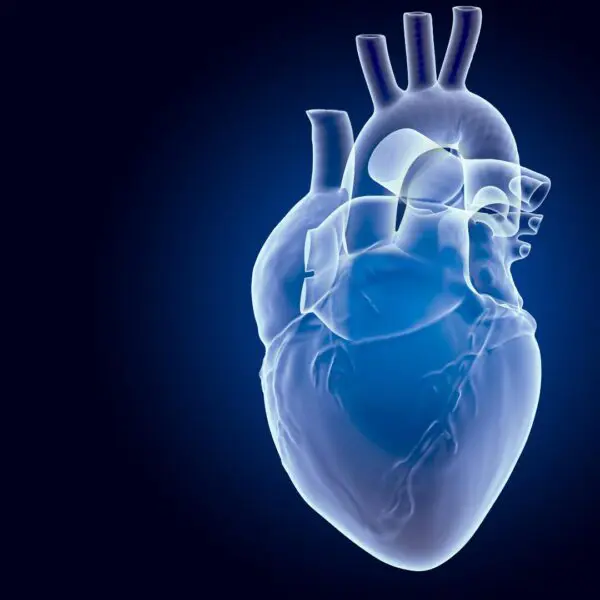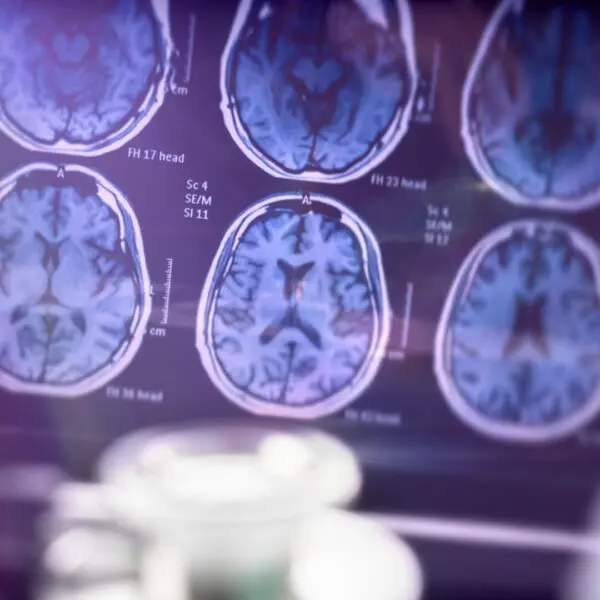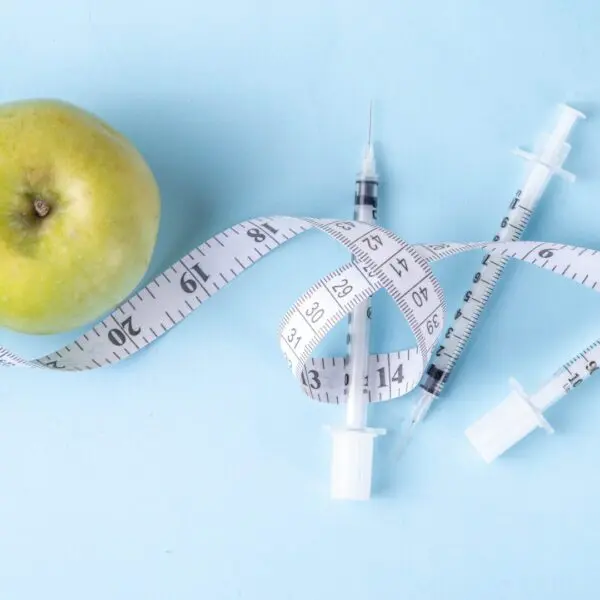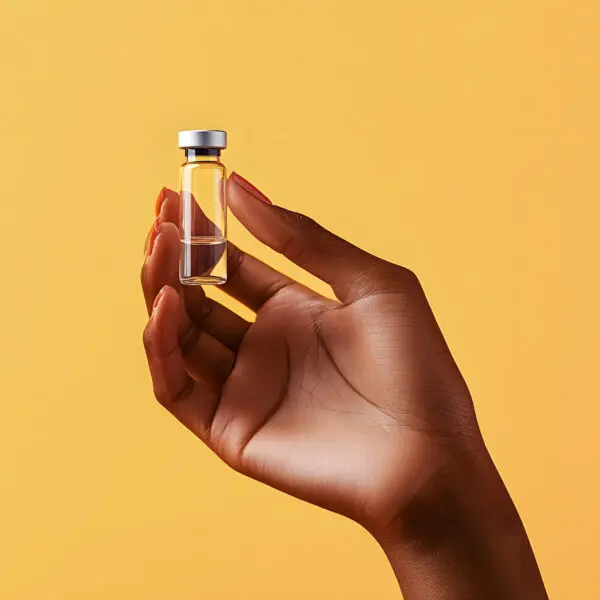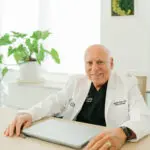Light of specific wavelengths can activate certain light-sensitive compounds, putting them in an excited state capable of undergoing photochemical reactions. This phenomenon is known as photoactivation. Studies show that when exposed to red light, the compound methylene blue undergoes a photodynamic response that generates reactive oxygen species like singlet oxygen. Previously, we used a red light therapy bed and sometimes a laser wristwatch. However, we have taken this process further by photo activating curcumin and methylene blue simultaneously using the PurLight device, pictured below. This represents the next level in our photoactivation capabilities.
The PurLight device is our invention, and it is mainly used to activate various cellular products, such as PRP, adipose tissue, and bone marrow aspirate, which we inject into a patient. It has multiple colors that can be used in conjunction or separately. We can also vary the intensity and strength of the light wave. One day, we had a revelation. We devised the concept of photo activating the curcumin, or methylene Blue, in the PurLight before giving it to the patient intravenously. This method will dramatically increase the efficacy of photoactivation since we have previously used a red light bed, as pictured below.
I still like the red light bed because it can benefit our cells and organs and is a good addition when using methylene blue. However, it cannot photo activate the methylene blue as efficiently as the PurLight since the light rays need to penetrate and reach the body’s tissues to eventually reach the methylene blue. The red light bed works well with methylene Blue, but will not work for Curcumin since Curcumin requires a blue light for Photodynamic therapy. There are some blue-type light beds, but they do not work very efficiently. This is where the PurLight shines; no pun intended. We can directly subject the Curcumin to an intense blue light to photo activate it before its intravenous infusion. Only a handful of facilities worldwide have the purlight technique available to perform this type of photoactivation.
Getting Into More of The Science
To review again, photoactivation refers to using specific wavelengths of light to catalyze or “activate” a light-sensitive compound into an excited state that can then participate in photochemical reactions in the body. Researchers have found that exposing methylene blue to red light causes a photodynamic response that generates reactive oxygen species (ROS) like singlet oxygen. While ROS are often associated with oxidative stress and cell damage, controlled and localized production of ROS has many beneficial applications in medicine. This is the basis of Photodynamic therapy, which uses light-activated photosensitizers to generate cytotoxic ROS that can selectively kill diseased or infected cells. Photodynamic therapy (PDT) is an emerging treatment modality that combines light-sensitive compounds, called photosensitizers, with specific wavelengths of light to target and destroy diseased or abnormal cells selectively. Another promising photosensitizer explored is curcumin, a natural compound derived from turmeric. Curcumin and methylene blue offer numerous potential patient benefits when used in PDT, making this approach an exciting avenue in modern healthcare. This is especially true with the PurLight.
Many studies have shown that curcumin and methylene Blue can treat several conditions. While sparing healthy tissues, PDT using Curcumin or methylene blue selectively accumulates in diseased cells for several reasons. Upon light activation, these photosensitizers generate reactive oxygen species that trigger cell death in the targeted areas, minimizing collateral damage to surrounding healthy cells and tissues. There is a large amount of research on this aspect. Another aspect of this therapy concerns its antimicrobial and anti-inflammatory properties. Both curcumin and methylene blue exhibit potent antimicrobial and anti-inflammatory properties, making PDT an attractive option for treating localized infections and inflammatory conditions. By combating bacterial, fungal, or viral infections while reducing inflammation, PDT can promote faster healing and recovery for patients suffering from various ailments. We also must remember that childhood viruses, such as Epstein-Barr and CMV viruses, start becoming more active as we age. Photoactivated curcumin and methylene blue can keep these viruses at bay and diminish their numbers. These viruses contribute to inflammaging, a condition where inflammation leads to accelerated aging. Keeping their numbers down will slow aging.
Viruses like Epstein-Barr virus (EBV) and cytomegalovirus (CMV) can cause cells to become senescent or inactive through various processes, such as suppressing proteins that regulate the cell cycle or causing the cells to stop dividing normally. The chronic or long-lasting viral infections from these viruses and the immune responses they trigger contribute to an increase in exhausted, senescent T cells, which is a characteristic of the aging immune system. The research indicates that reactivation of both CMV and EBV is associated with an increase in senescent T cells. Still, CMV reactivation has a stronger connection to frailty and aging than EBV. Long-term viral infections and immune responses are crucial in increasing inactive senescent cells during aging. Other diseases like Lyme and mold can also respond to these PDTs.
Preclinical studies have demonstrated the promising anticancer effects of curcumin and methylene blue when used in PDT. This approach has shown the ability to selectively target and destroy cancer cells while minimizing harm to healthy tissues. PDT may offer an alternative or adjuvant treatment option for certain types of cancer, potentially improving patient outcomes and reducing the need for more invasive or systemic therapies. Currently, we do not recommend nor use PDT for cancers, but there is active research in this field.
Enhanced Wound Healing
Combining curcumin’s antimicrobial, anti-inflammatory, and tissue-regenerative properties in PDT can facilitate faster and more effective wound healing. By reducing infection risk, controlling inflammation, and stimulating the production of growth factors, PDT may aid in the recovery process for patients with chronic or non-healing wounds, improving their overall quality of life. The same holds for methylene blue.
Neuroprotective Effects
Surprisingly, studies suggest photo activated methylene blue may protect neurons from degeneration and death associated with neurodegenerative diseases like Alzheimer’s, Parkinson’s, and stroke. The exact mechanisms are still being elucidated but may involve ROS signaling pathways, increased mitochondrial function, and inhibition of toxic protein aggregation.
Metabolic Effects
Evidence shows photoactivated methylene blue can modulate cellular metabolism, improve mitochondrial function, and enhance ATP production. This could benefit various metabolic disorders and increase energy levels.
Anti-Aging Effects
Photoactivated methylene blue may delay or reverse specific cellular processes associated with aging by improving mitochondrial function, reducing oxidative stress, and promoting survival pathways.
Improved Mitochondrial Health May Be The Most Important Health Benefit of PDT
Mitochondria are the powerhouses of our cells, responsible for generating most of the cellular energy in the form of ATP through oxidative phosphorylation. Mitochondrial dysfunction has been implicated in a wide variety of diseases and conditions, including neurodegenerative disorders, metabolic diseases, cancer, and aging. Interestingly, research has shown that photoactivated methylene blue and curcumin can positively impact mitochondrial health and function through several vital mechanisms.
Increasing Mitochondrial Membrane Potential
Methylene blue concentrates in mitochondria without photoactivation due to its positive charge and lipophilic (affinity for fats) nature. Photoactivation and generating reactive oxygen species (ROS) enhance the mitochondrial membrane potential. This diagram shows many different aspects of the electron transport chain.
The mitochondrial membrane potential is the electrochemical gradient that drives ATP synthesis across the inner mitochondrial membrane in the electron transport chain. By increasing this potential, photoactivated methylene blue directly potentiates mitochondria’s ability to produce ATP. Free radicals are also produced at the same time that ATP is produced. Free radicals are mainly generated at two critical points in the electron transport chain. The first point is Complex I. Complex I is a large protein complex that helps move electrons through the chain. Sometimes, the electrons can “escape” from Complex I and react with oxygen to form a free radical called superoxide (O2•-). The production of these free radicals at Complex I depends on specific molecules like NADH and NAD+ levels.
Complex III is another protein complex involved in the electron transport chain. Free radicals, particularly superoxide, can be generated at two specific sites within Complex III. In addition, free radicals can also be made when electrons get “pushed back” from later stages in the chain to the earlier Complex I, which happens when there is a high proton gradient and NADH/NAD+ ratio. In summary, the main hotspots for free radical production in the electron transport chain are Complexes I and III, where electrons can “leak out” and react with oxygen. The exact amounts depend on the activity and state of these complexes.
Modulating Mitochondrial Metabolism
With light activation, methylene blue can help mitochondria produce energy more efficiently. Mitochondria generate most of a cell’s energy supply through the electron transport chain. The electron transport chain is a crucial process within cells’ mitochondria, where it plays a vital role in producing energy in the form of ATP. A series of protein complexes and electron carriers facilitate the transfer of electrons, ultimately leading to the generation of a proton gradient that drives the synthesis of ATP. The process begins when electrons are released from molecules like NADH and FADH2, produced earlier in cellular respiration. These electrons then flow through a series of protein complexes, each extracting a small amount of energy from the electrons. As the electrons move through the chain, they release energy that is used to pump protons (hydrogen ions = H+) across the inner membrane of the mitochondria, creating a concentration gradient. This proton gradient then drives the enzyme ATP synthase, which uses the energy stored in the gradient to phosphorylate ADP, converting it into ATP, the primary energy currency of the cell. The electron transport chain is highly efficient, as it can generate up to 36-38 ATP molecules per glucose molecule, making it a crucial component of cellular respiration and energy production. Because this process uses oxygen, it creates ROS, also known as free radicals.
In this process, electrons are passed along a series of molecules, creating an electrical gradient that allows ATP (the cell’s energy currency) to be produced. However, this electron transport process sometimes gets blocked or deficient, reducing ATP production. Methylene blue can be an alternative way to cycle and transport electrons in the chain. By accepting and shuttling electrons through its redox (reduction-oxidation) reactions, methylene blue bypasses any roadblocks in the normal pathway.
This alternate route for electrons helps maintain the proton gradient and membrane potential that drives ATP synthesis. It also prevents the build-up of harmful reactive oxygen species that can occur when the electron transport stalls. Light-activated methylene blue enhances mitochondrial metabolism by acting as an additional electron carrier. This alternate electron cycling pathway overcomes deficiencies, increases mitochondrial efficiency, and boosts the cell’s production of ATP energy molecules. By facilitating electron transport, Methylene blue can enhance ATP production in mitochondria, thereby increasing cellular energy levels and improving mitochondrial function. Finally, some studies suggest that methylene blue may modulate mitochondrial dynamics, including fusion and fission processes, which are crucial for maintaining a healthy mitochondrial network.
Reducing Oxidative Stress
Although initially exposing methylene blue to light generates some reactive oxygen species (ROS) like singlet oxygen, which can be damaging, methylene blue has a unique ability to cycle between oxidized and reduced states. Over time, this redox cycling reduces the overall level of oxidative stress inside mitochondria. Methylene blue is an antioxidant that rapidly neutralizes other highly reactive oxidizing species. This reduction in oxidative damage helps protect the DNA, proteins, and lipids (fats) inside mitochondria from being broken down by oxidation. Preventing this kind of oxidative degradation is critical because mitochondrial dysfunction caused by oxidative damage is a crucial factor in aging and many diseases. In simpler terms, although light activation initially creates some reactive oxygen, methylene blue cycles in a way that ultimately lowers the overall oxidizing reactive species inside mitochondria over time. This protects the structures and molecules inside mitochondria from oxidative damage, accumulating with age and disease. It can preserve the function of our immune system, which is essential to our health and healthspan.
Promoting Mitochondrial Biogenesis
Some evidence suggests photoactivated methylene blue may upregulate the production of new mitochondria through a process called mitochondrial biogenesis. This involves activating specific transcription factors that increase mitochondrial proliferation. A transcription factor gives instructions to genes to produce certain compounds. Boasting both mitochondrial quality and quantity could rejuvenate and increase cellular energy production capacity. This is one of the reasons why we recommend Methylene Blue after an EBO2 treatment (the treatment will increase NAD levels) or after intravenous NAD.
Inhibiting Mitochondrial Permeability
Methylene blue is a compound that can help prevent cell death by acting on the mitochondria. A channel in mitochondria called the mitochondrial permeability transition pore (MPTP) plays a crucial role in initiating programmed cell death or cellular suicide. Research has shown that methylene blue can inhibit or block the opening of this MPTP channel. By keeping the MPTP closed, methylene blue may protect mitochondria and promote cell survival instead of cell death. This ability to prevent excessive cell death could potentially be beneficial for treating conditions where too many cells die, such as neurodegenerative diseases like Alzheimer’s, stroke, and other brain injuries or exposure to toxic substances. Methylene blue seems to have this protective, anti-cell death effect when activated by light. Overall, the combination of metabolic modulation, reduced oxidative stress, enhanced biogenesis, and anti-apoptotic effects positioned photoactivated methylene blue as a potentially powerful mitochondrial “energizer” and protector.
Any Problems With Intravenous Methylene Blue?
Intravenous methylene blue can diminish the body’s production of Nitric Oxide (NO) primarily by inhibiting the activity of certain enzymes involved in NO synthesis. Nitric oxide is a signaling molecule that plays crucial roles in various physiological processes, such as vasodilation (widening of blood vessels), neurotransmission, and immune responses. It is produced by a family of enzymes called nitric oxide synthases (NOS). A nitric oxide supplement like Neo40 can help counteract the reduction in Nitric Oxide levels caused by intravenous methylene blue administration. As was said, when methylene blue is given intravenously, it inhibits the enzymes (iNOS and nNOS) responsible for producing nitric oxide in the body. This can decrease overall nitric oxide levels, which can have various physiological consequences, as nitric oxide is essential in regulating blood flow, neurotransmission, and immune function. Neo40 and SuperBeets are dietary supplements containing ingredients like L-arginine and nitrates, which are precursors for producing nitric oxide in the body. These supplements should be taken daily to maintain one’s health. Providing these precursors can help increase the bioavailability of nitric oxide, thereby compensating for the reduction caused by methylene blue. This is a rule in our office. Optimizing mitochondrial function and overcoming dysfunction could alleviate or prevent a wide array of mitochondrial-related diseases while extending healthy lifespans by delaying mitochondrial decay associated with aging. One caution with methylene blue is that it should not be taken by patients who are taking antidepressants. The reason is that methylene blue can work much like antidepressants and increase serotonin levels.
How About Curcumin?
Curcumin has many of the same benefits as methylene blue. It is a more potent agent for reducing inflammation. It does this by activating a pathway in the body called the NRF2 pathway. NRF2 is a transcription factor that helps the body produce potent anti-inflammatory agents. On the other hand, methylene blue may be more effective in generating ATP. Both have their benefits, and the best situation might be utilizing both but at different times.
As we can see, Photodynamic therapy with methylene blue and curcumin has many benefits for our health and health span. PurForm has a unique method of performing Photodynamic therapy with the PurLight. This is in keeping with our philosophy at PurForm. At PurForm, we don’t just practice regenerative medicine. We define it!
*THESE STATEMENTS HAVE NOT BEEN EVALUATED BY THE FDA.
